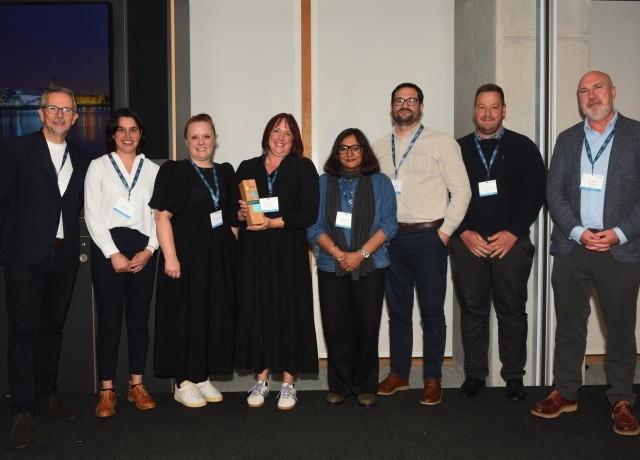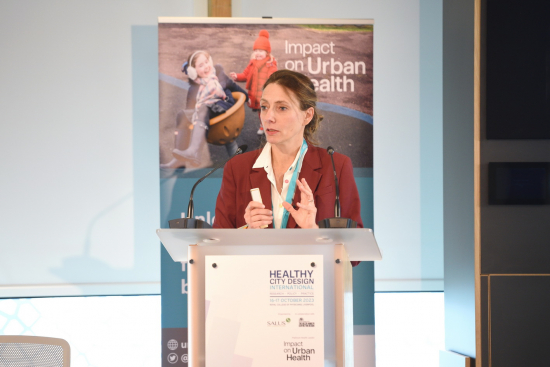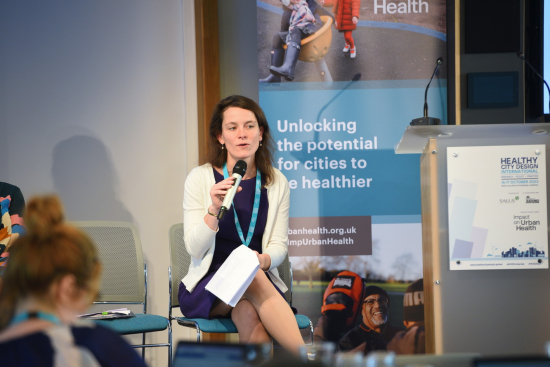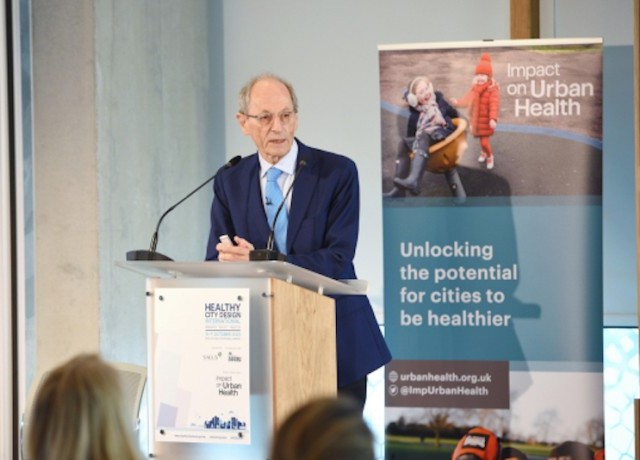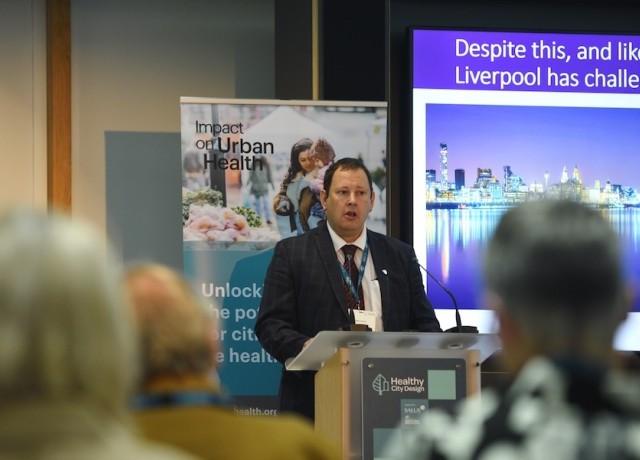
Keynote summary: Health 2040 – system working towards a healthier Liverpool
“If you have a healthy population, the local economy tends to do well. If you have an unhealthy population, the local economy tends to suffer.”
This was the assertion from Professor Matt Ashton, director of public health at Liverpool City Council, as he delivered the opening keynote at the Healthy City Design Congress 2024 in Liverpool.
Prof Ashton took the opportunity to explore his ‘State of health in the city report: Liverpool 2040’, issued earlier this year, which highlighted the poor health outcomes the city experienced and warned that without immediate collective action, these outcomes were expected to decline further by 2040.
Sharing some of the stark statistics, Prof Ashton showed that people in Liverpool live 3.5 fewer years than the England average. Some 1900 women die under the age of 75 every year, with 1100 of those deaths deemed entirely preventable. More than 90,000 people living in the city have a major illness, of which the big killers are cancer, cardiovascular disease and respiratory disease. There are major inequalities, too – “If you live in our poorest areas, you are likely to live 15 years less compared with someone living in the most affluent areas, and of those years, you will live 18 years in poor health,” said Prof Ashton.
Future trends
Projecting forward current trends to 2040 and the situation gets increasingly worrying. For men, life expectancy is actually expected to see a small increase; however, life expectancy for women would fall by one year, with women also expected to live an extra four years in poor health. Overall, residents are estimated to live over a quarter of their lives in poor health.
“We estimate there will be an extra 38,000 people living with major illness,” added Prof Ashton. “These people are at risk of needing higher levels of health and social care support, placing more pressure on a system that is significantly overstretched.” Also predicted are higher levels of diabetes, asthma, kidney disease, cancer, hypertension, and a near doubling of people living with depression in the city.
And once poor health sets in, it can be a hard cycle to break. “Taking a life course approach, we know from the evidence that poor health in adults can mean parents are out of work, and this has a negative impact on children’s physical and mental health, on children’s educational attainment, school absenteeism, and then the cycle continues,” Prof Ashton observed.
Describing the drivers of poor health, he pointed out that it’s widely accepted that at least 50 per cent of our health is determined by socio-economic factors and the built environment. It’s estimated that between 30 and 40 per cent of our health is determined by how people behave and the choices they make, while between 15 and 25 per cent of our health is estimated to be determined by healthcare.
“We need to create the right environment so that making the healthy choice is the easiest and most affordable choice to make,” said Prof Ashton, “through local strategies, national legislation, and behaviour of commercial organisations.”
He continued: “Healthy city initiatives in Liverpool aim to promote health and wellbeing through strong community engagement, improved urban planning, and accessible health and wellbeing services. Focus is on addressing the social determinants of health, such as good quality housing and urban design, high-quality education, and healthy environments, to create those healthy living conditions. Unfortunately, for many people in Liverpool, these building blocks are missing or need strengthening.”
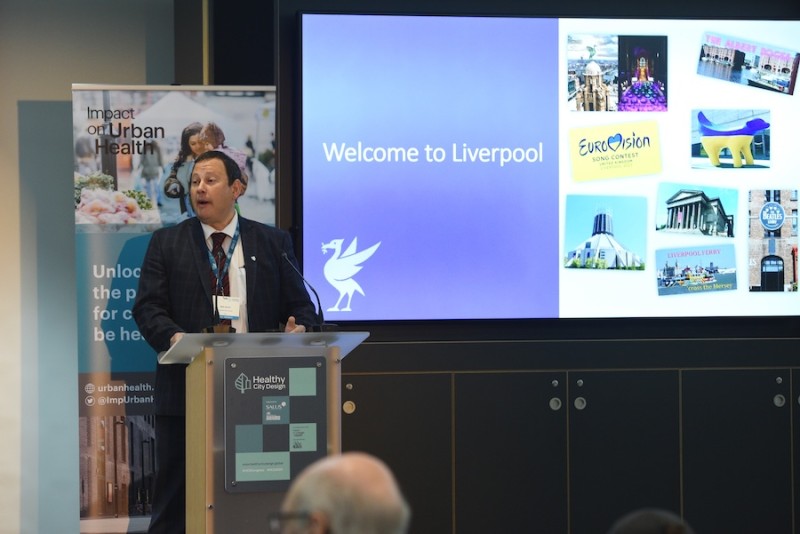
Health in all policies
Describing how the Council is trying to create a healthy Liverpool, Prof Ashton highlighted work to develop a new model for health literacy citywide, as well as providing detail on implementing a ‘health in all policies’ (HiAP) approach to encourage ill health prevention.
“The HiAP approach has involved working collaboratively across the whole council to leverage existing powers and policies,” said Prof Ashton. “It involves joint work on the refresh of the City Plan; development of our housing and homelessness strategy; development of our inclusive economic growth strategy; adoption of a refreshed corporate advertising and sponsorship policy; close working on the air quality and climate change agenda; development of a new city mobility strategy with active travel at the heart of it; and large-scale regeneration schemes like Festival Gardens, Anfield, Everton and central docks.”
The Council’s planning and public health team are currently working together via a Memorandum of Understanding to embed some of Sir Michael Marmot’s ‘Marmot city’ and health equity principles into a health impact assessment to ensure that social determinants of health are effectively addressed at the earliest stage of the planning process. A housing design guide is also under development to incorporate healthy home principles.
Nevertheless, Prof Ashton was also adamant that more assistance is required. To address over a decade of austerity and resulting inequalities and rising poverty, the ‘State of health in the city’ report calls on national government to push forward with devolved powers on health to support local organisations to improve health outcomes and reduce health inequalities at pace and scale. National government, he said, needs to provide stronger policy and legislative levers to address priority areas, including the revision of the National Planning Policy Framework and other policy and design codes. He added, too, that changes are needed in respect of future national funding for health and care services in the city, including preventive investment.
We should be focusing intensively on co-design and co-production, doing things with communities and never to them
“We also need the support of local people and local communities,” said Prof Ashton. “We need people, organisations and sectors to work collaboratively to put health at the heart of decision-making. We need to learn from each other across the UK and internationally to identify what works to make our cities of the future genuinely healthy ones. We need to show leadership to drive city developments and not just try the same things as we’ve always done.”
He added: “Most importantly, we need to empower our communities, to give them a voice, and help them make healthy choices for themselves and their neighbours. We should be focusing intensively on co-design and co-production, doing things with communities and never to them.”
These and other measures could help shift the trajectory and avoid some of the worst poor health outcomes predicted for 2040.
“The future is not set,” stressed Prof Ashton. “Nationally, a reduction in child poverty of 25 per cent by 2033 could lead to 293 fewer infant mortality cases, 4696 fewer looked after children, and 32,650 fewer emergency admissions. We all have a role to play in creating healthy cities.”
Event news
Advancing health equity through place-based impact investing
7th November 2024
Health 2040 – system working towards a healthier Liverpool
1st November 2024
HCD 2024 Welcome address
1st November 2024






